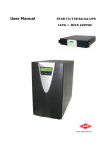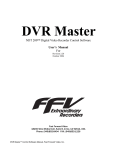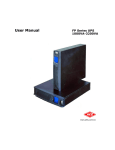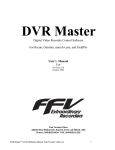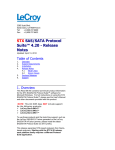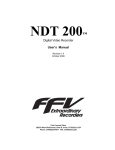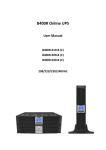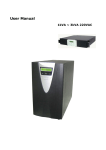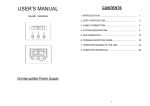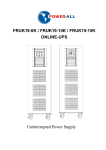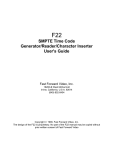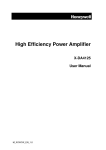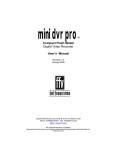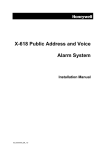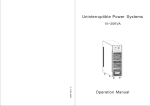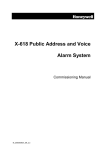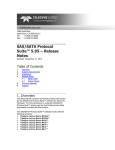Download Star T3 6~10kVA User manual August 2006
Transcript
User Manual STAR T3 Series UPS 6/10 kVA www.allis.com.tw User manual 6/10 kVA Rev.4 Contents 1. Presentation ....................................................................................................... 1 1.1 General Description ........................................................................................... 1 1.2 System Configuration......................................................................................... 2 1.3 Front Panel ...................................................................................................... 3 ? ? LCD............................................................................................................ 3 ? ? LED............................................................................................................ 3 1.4 Rear Panel ....................................................................................................... 4 ? 6/10 kVA..................................................................................................... 4 ? Extended Battery Bank .................................................................................. 5 2. Installation......................................................................................................... 6 2.1 Unpacking........................................................................................................ 6 2.2 Installation ...................................................................................................... 7 ? Standard ..................................................................................................... 7 ? External Battery ........................................................................................... 8 ? Parallel........................................................................................................ 9 2.3 Connection to communication............................................................................ 10 2.3.1 Standard ................................................................................................. 10 ? RS-232 ............................................................................................ 10 2.3.2 Optional Interface Cards............................................................................. 11 ? USB Card.......................................................................................... 11 ? DB9 Dry Contact Card......................................................................... 11 ? AS400 Card ...................................................................................... 12 ? SNMP/HTTP Agent .............................................................................. 12 3. Operation ......................................................................................................... 13 3.1 LCD and LED Display ....................................................................................... ? LCD.......................................................................................................... ? LED.......................................................................................................... 3.2 Starting up/ Shutting down the UPS ................................................................... 3.3 Operation Modes ............................................................................................. 3.4 Configuration Settings...................................................................................... ? Output Voltage / Frequency.......................................................................... ? Bypass Voltage........................................................................................... 13 13 15 16 17 18 18 19 4. Maintenance ..................................................................................................... 20 4.1 General Maintenance ....................................................................................... ? Environment .............................................................................................. ? Storing the UPS and Battery ......................................................................... ? Replace the Battery..................................................................................... 4.2 Replacing the New Battery ................................................................................ 4.3 Testing the New Battery ................................................................................... 4.4 Recycling the Used Battery ............................................................................... 4.5 Maintenance Bypass ........................................................................................ ? Switch to bypass......................................................................................... ? Return from bypass to normal mode .............................................................. 20 20 20 20 21 21 21 22 22 22 5. Troubleshooting ................................................................................................ 23 ? ? LCD.......................................................................................................... 23 LED.......................................................................................................... 25 6. Appendix .......................................................................................................... 28 6.1 Specifications ................................................................................................. ? General Specification................................................................................... ? Battery Run Time ........................................................................................ 6.2 Contact Information......................................................................................... ALLIS ELECTRIC -i- August 2006 28 28 29 30 User manual 6/10 kVA Rev.4 Important Safety Instructions SAVE THESE INSTRUCTIONS. This UPS unit operates from utility power and contains a number of high current back-up batte ries, the information is important to all personnel involved. Please read this manual first before installation and operation of the UPS. Safety of Persons ? Opening or removing the cover of the unit may expose you to lethal voltage within the unit even it is apparently not operated and the input wiring is disconnected from electrical source. ? Refer all UPS and battery service to authorized service personnel from the manufacture or agent authorized by the manufacturer. ? Do not dispose of battery in a fire. The battery may explode. ? Do not open or damage the battery. Battery acid is toxic and harmful to eyes and skin. ? The following precautions should be observed when working on batteries: ? Remove watches, rings, and other metal objects. ? Use tools with insulated handles. Product Safety ? Install the UPS in a clean environment, free from moisture, flammable gases or fumes and corrective substances. ? Keep the UPS on a flat, stable surface with 50cm space around it for proper ventilation. ? Operate the UPS in an indoor environment only in an ambient temperature range of 32oF to +104 oF (0 oC to +40oC). The UPS is designed for data processing equipment. It is not intended for use with life support and other designated “critical” devices. ? Maximum load must not exceed that shown on the UPS rating label. ? Storing magnetic media on top of the UPS may result in data loss or corruption. ? Once batteries have reached the end of their life, ensure they are disposed properly. REFER TO YOUR LOCAL LAWS AND REGULATIONS FOR BATTERY DISPOSAL REQUIREMENTS. ? The UPS must be handled with care and attention since the high energy stored within the batteries. It must always be kept in the position The battery should be maintained at regular intervals marked on the external packaging and must not be dropped. ? Please keep the exhaust holes of UPS unobstructed. ? The battery should be maintained at regular intervals Special Precautions ? The UPS should be installed according to the instructions in this manual. Failure to do so could result in safety issues. It could also invalidate your warranty. ? DO NOT CONNECT equipment that could overload the UPS or demand half-wave rectification from the UPS, for example: electric drills, vacuum cleaners, printers or hair dryers. ? Adjust only those controls that are listed by the Adjustment Section. If the unit does not operate normally by following the operating instructions, contact the sales representatives. Icon Usage These icons may be found in the contents. WARNING: Obvious danger to personnel or equipment. CAUTION: Possible danger to personnel or equipment Important information ALLIS ELECTRIC -ii- August 2006 User manual 6/10 kVA Rev.4 Limited product warranty and policy ? Limited Product WarrantyAEC warrants this equipment, when properly applied and operated within specified conditions, against faulty materials or workmanship for a period of 24 months after the date of purchase. For equipment located outside Taiwan, AEC only covers faulty parts. AEC products repaired or replaced pursuant to this warranty shall be warranted for the unexpired portion of the warranty applying to the original product. This warranty applies only to the original purchaser. This warranty does not cover shipping costs, installation costs, maintenance and service items, calibration and adjustment. Repair or replacement of a defective part, or the crediting to the user of the value thereof, does not extend the original warranty period. ? Warranty policyThe warranty shall be void if (a) the equipment is damaged by the customer, is improperly used, is subjected to an adverse operating environment, or is operated outside the limits of its electrical specifications; (b) the equipment is repaired or modified by anyone other than AEC or AEC-approved personnel; or (c) has been used in a manner contrary to the product’s operating manual or other written instructions. All claims under this warranty must be submitted in writing to AEC within 30 days of the occurrence or the claim will not be considered. This warranty does not include damage resulting from accident or misuse. AEC reserves the right to determine whether the damage to the connected equipment is due to malfunction of the AEC product by requesting the equipment in question to be sent to AEC for examination. This policy is above and beyond, only to the extent needed, of that provided by any coverage of connected equipment provided by other sources, including, but not limited to, any manufacturer's warranty and/or any extended warranties. EXCEPT AS PROVIDED ABOVE, AEC MAKES NO WARRANTIES, EXPRESS OR IMPLIED, INCLUDING WARRANTIES OF MERCHANTABILITY AND FITNESS FOR A PARTICULAR PURPOSE. EXCEPT AS PROVIDED ABOVE, IN NO EVENT WILL AEC BE LIABLE FOR DIRECT, INDIRECT, SPECIAL, INCIDENTAL OR CONSEQUENTIAL DAMAGES ARISING OUT OF THE USE OF THIS PRODUCT, EVEN IF ADVISED OF THE POSSIBILITY OF SUCH DAMAGE. Specifically, AEC is not liable for any costs, such as lost profits or revenue, loss of equipment, loss of use of equipment, loss of software, loss of data, costs of substitutes, claims by third parties or otherwise. Coverage also does not apply to connected medical and industrial equipment. To receive service under this warranty, you must be the original purchaser/user of the product in question. You must obtain a Returned Material Authorization (RMA) number fro m AEC. Products must be returned to AEC with transportation charges prepaid and must be accompanied by a brief description of the problem encountered and proof of date and place of purchase. The policy of AEC is one of continuous improvement. Specifications are subject to change without notice. ALLIS ELECTRIC -iii- August 2006 User manual 6/10 kVA Rev.4 1. Presentation 1.1 General Description The continuity of electrical power is an essential requirement for critical load operations .The Uninterruptible Power System (UPS) is a compact and quiet solution for power protection of computer, server and office equipment. To choose the UPS as your equipment protector is a wise investment as it supplies reliable, pure and stable power at an affordable price. Feature & Benefits: ? True on-line double conversion ? PWM tec hnologies w/ IGBTs ? Wide input voltage range ? DC Start ? Battery self-test ? Microprocessor based control ? User-friendly LCD or LED ? Communication ports: Standard RS232 and optional communication slot for either DB9, USB, AS-400 or SNMP/HTTP card. ? Light weight unit ? Optional external battery slot for long runtime requirement ? DSP Technology ? Parallel redundancy capability Application: ? Computers ? Network Servers ? Workstations ? Wireless Communication ? Other Electronic Peripherals ALLIS ELECTRIC - Page 1 of Total 30 - August 2006 User manual 6/10 kVA Rev.4 1. Presentation 1.2 System Configuration 6kVA: 260W x 717H x 570D mm / 90 kgs 10kVA: 260W x 717H x 570D mm / 93 kgs ALLIS ELECTRIC - Page 2 of Total 30 - August 2006 User manual 6/10 kVA Rev.4 1. Presentation 1.3 Front Panel ? LCD 1 2 3 4 5 6 7 1. 2-line LCD Display 2. Normal LED (green) 3. Warning LED (yellow) 4. Fault LED (red) 5. Select-up button 6. Select-down button 7. Enter button 5-6. Off button 6-7. On button 5-7. Test/Silence button ? LED 1 2 3 4 5 6 7 8 9 1. Line LED (green) 2. Load & Battery Capacity LEDs 3. Battery LED (yellow) 4. Bypass LED (yellow) 5. Fault LED (red) 6. Inverter LED (green) 7. Select-up button 8. Select-down button 9. Enter button 7-8. Off button 8-9. On button & Test/Silence button ALLIS ELECTRIC - Page 3 of Total 30 - August 2006 User manual 6/10 kVA Rev.4 1. Presentation 1.4 Rear Panel ? 6/10 kVA ?1 ?1 ?2 ?2 ?7 ?7 ?6 ?6 ?3 ?3 ?5 ?5 ?4 ?4 6 kVA 1. 2. 3. 4. 5. 6. 7. 10 kVA Communication ports: Standard RS232 Port & DB9, USB, AS400, SNMP/HTTP (Option) Fan Input Breaker Inlet & Outlet (Terminal Block) Maintenance Bypass Switch External Battery Slot (Option) Parallel port ALLIS ELECTRIC - Page 4 of Total 30 - August 2006 User manual 6/10 kVA Rev.4 1. Presentation ? Extended Battery Bank ALLIS ELECTRIC - Page 5 of Total 30 - August 2006 User manual 6/10 kVA Rev.4 2. Installation 2.1 Unpacking You may find the “series number” labeled on both shipping box and UPS rear panel. If the UPS has a problem please send the number to your sales representative for tracking and troubleshooting. The Star T3 Series UPS can be supplied in a varied number of boxes depending upon the model ordered. The number of boxes provided should be as follows: MODEL (Box 1) ST3060 ST3100 TOTAL BOXES 1 Box 1 Box Star T3 Series 6/10kVA Tower Box 1 ? ? ? ? Shipping Box Includes: 1. UPS 2. User Manual 3. 25-pin Serial Communication cable (Option for parallel units only) 4. External Battery Cable for long runtime units (Option: 3-port for 6kVA, 5-port for 10kVA) ALLIS ELECTRIC - Page 6 of Total 30 - August 2006 User manual 6/10 kVA Rev.4 2. Installation 2.2 Installation ? Standard ? ? ? Keep the UPS on a flat, stable surface with 50cm space around it for proper ventilation. Installation and wiring must be following the local electric code and introduction below. Turn off the UPS and equipments before installation. 1 2 3 4 5 6 7 8 1. Input Ground 6. Output Line 2. Input Neutral 7. Output Neutral 3. Input Line 8. Output Ground 4 & 5. Connect JP1 and JP2 via 10AWG (6mm2) for single usage, disconnect JP1 and JP2 for parallel usage. (1) Remove the cover of the terminal block, please use the above table and diagram on the back panel for correctly cabling the UPS. (2) Ensure the earth/ground cable is correctly sized according to electrical regulations. (3) After making connections, double check the wiring is correct and wires are secure. (4) *IMPORTANT* - If an earth leakage protection device (RCD) is to be used on the installation, this must be installed between the output of the UPS and the distribution board. It must not be before the input of the UPS. (5) Ensure all load equipment is turned off before starting UPS. The load equipment must be started one by one to avoid inrush current. (6) *WARNING* - AC and DC voltages can still be present on the terminal blocks even with the mains supply disconnected. Always check with a multi- meter before handling cables or connections. ? ? ? ? ALLIS ELECTRIC Suggest the UL 1015 10AWG(6mm2 ) wire used in 6kVA for input and output wirings. Suggest the UL 1015 8AWG(10mm2 ) wire used in 10kVA for input and output wirings. Please allow the UPS to charge its batteries for 24 hours before turning it on. Your connected equipment will still receive power while the UPS is off. Backup time may be shortened if the UPS is not charged first. Please calculate the capacity of UPS to include start-up of currents of any necessary inductance loads such as monitor and printer, etc. - Page 7 of Total 30 - August 2006 User manual 6/10 kVA Rev.4 2. Installation ? External Battery for battery bank for loosing batteries (1) For the long runtime application, please make sure the battery voltage must be 240 VDC nominal. (2) Connect the external battery with the proper external battery cable as shown pictures above. (3) After making connections, double check the wiring is correct and wires are secure. ALLIS ELECTRIC - Page 8 of Total 30 - August 2006 User manual 6/10 kVA Rev.4 2. Installation ? Parallel ? ? ? ? For parallel operation, JP1 & JP2 on the terminal block of each UPS should be disconnected Keep the UPS on a flat, stable surface with 50cm space around it for proper ventilation. Installation and wiring must follow the local electric al regulations and instructions below. Turn off the UPS and equipments before installation. (1) Remove covers from parallel slots on each UPS then use 3 meter 25-pin communication cable to connect UPS to each other. (2) Remove the cover of the terminal block, please use the above table and diagram on the back panel for correctly cabling the UPS. (3) Ensure the earth/ground cable is correctly sized according to electrical regulations. (4) After making connections, double check the wiring is correct and wires are secure. (5) *IMPORTANT* - If an earth leakage protection device (RCD) is to be used on the installation, this must be installed between the output of the UPS and the distribution board. It must not be before the input of the UPS. (6) Ensure all load equipment is turned off before starting UPS. (7) Start up each UPS one by one and make sure all UPS are working in normal mode. (8) Measure the voltage at JP1 & JP2 on each UPS. If the difference between them is greater than 1 VAC, please check the output relay and restart the UPS. (9) Please measure the JP2 points (one on each units) the voltage difference between these two units should be less than 5 VAC (2VAC generally). If the voltage more than 5 VAC, please check the 25-pin communication cable. (10) The load equipment must be started one by one to avoid inrush current. (11) *WARNING* -AC and DC voltages can still be present on the terminal blocks even with the mains supply disconnected. Always check with a multi- meter before handling cables or connections. ALLIS ELECTRIC - Page 9 of Total 30 - August 2006 User manual 6/10 kVA Rev.4 2. Installation 2.3 Connection to communication 2.3.1 Standard ? RS-232 The communication interface (DB9 port) on the back of the UPS may be connected to a host computer with specific monitoring software installed. (Please contact sales representative for further information of monitor software) The pins of the connector are as following: PIN # 2 3 5 PIN Definition (UPS) Transmitted data Received data Signal Ground PIN Definition (PC) Received data Transmitted data Signal Ground The RS-232 interface settings are as follows: Baud Rate Data Length Stop Bit Parity ALLIS ELECTRIC 2400 bps 8 bits 1 bit None - Page 10 of Total 30 - August 2006 User manual 6/10 kVA Rev.4 2. Installation 2.3.2 Optional Interface Cards A variety of interface cards can be installed into optional communication slot such as DB9 Dry Contact Card, USB Card, AS400 Card, and SNMP/HTTP Card. ? USB Card DB9 Dry Contact Card Pin Definition of DB9 for NOVELL Interface PIN # Function explanation I/O of DB9 1 UPS Fault Output 3 GND Input Remote Shutdown 4 UPS(+12VDC)(Work on Input Battery Mode) 5 Input 12VDC Input 6 Bypass Mode Output 7 Low Battery Output 8 9 Normal Mode, Battery Mode Utility Power Fault ALLIS ELECTRIC Output Output - Page 11 of Total 30 - August 2006 User manual 6/10 kVA Rev.4 2. Installation ? AS400 Card Please visit IBM’S website www.ibm.com for more information. ? SNMP/HTTP Agent (External) (Internal) NetAgent II allows a user to obtain the status, and issue commands to the UPS. The communications protocol includes the MegaTec/ PPC/ SEC 2400 / 9600. Also it is possible to build in your own protocol. NetAgent II provides a simple and easy installation procedure. The user only needs to install the software from the NetAgent II CD on a Windows environment and configure the IP address. All the other configurations could be accomplished in a Web browser. NetAgent II also provides shutdown programs for different operating systems. Shutdown commands can be sent for such events as power failure, low UPS battery condition, UPS overload, UPS overheating and scheduled shutdowns. All shutdown events are configurable by the user. The shutdown software provides an orderly shutdown to prevent the abnormal shut-off of clients or servers. Please refer to the NetAgent II installation CD for more information. ALLIS ELECTRIC - Page 12 of Total 30 - August 2006 User manual 6/10 kVA Rev.4 3. Operation 3.1 LCD and LED Display ? LCD “Select-Down” Key: ? ? “Select-Up” Key: The welcome screen only shows for 10 seconds as UPS starts up, after that the “UPS Status” will show on the display. The screen should go back to “UPS Status” if you do not push any buttons for 2 minutes. Display 1 - Welcome screen AEC Star T3 Series On-Line UPS Display 2 - Input/Output Voltage and Frequency Identification Display 3 – UPS Status Display 4 – Real Input/Output Voltage and Frequency Input:220V 50Hz Output:220V 50Hz AC:FAIL BATT:LOW NO Output Input Voltage 220 VAC Output Voltage 220VAC Input Frequency 50 Hz Output Frequency 50 Hz ALLIS ELECTRIC - Page 13 of Total 30 - August 2006 User manual 6/10 kVA Rev.4 3. Operation Display 5 – Battery Voltage/ Capacity Display 6 – Output Power Battery Voltage 240 VDC Output Power 100 % Display 7 – Inside Temperature Inside TEMP 33 ? 91 ? Display 8 – New Alarm NEW AC Fail: 1 ALM Overload: 3 Display 9 – Old Alarm OLD AC Fail: 5 ALM Overload: 9 Display 10 – Bypass Voltage Setting Display 11 – Output Voltage/ Frequency Setting ALLIS ELECTRIC Bypass Volt Set LO= 176V HI=253V Volt/Freq Set 220 VAC 50 Hz - Page 14 of Total 30 - August 2006 User manual 6/10 kVA Rev.4 3. Operation ? LED 1 6 7 8 9 10 2 3 4 5 1. Line LED (green): This indicates the AC power is applied to the UPS input. If the LED blinks, it means the AC power source is out of tolerance. 2. Battery LED (yellow): This indicates the UPS is in Battery Mode. 3. Bypass LED (yellow): This indicates the UPS is in Bypass Mode. 4. Fault LED (red): This indicates the UPS is in fault condition because of UPS shutdown or over-temperature 5. Inverter LED (green): This indicates the inverter is working normally. 6-10. Load & Battery Capacity LEDs: (a) No. 6 to 7 LED is green color, No. 8 to 9 is yellow and No.10 (used as warning LED for overload or battery low) is red. (b) These LEDs show the load (%) of the UPS if the AC input is available (in Normal Mode). LEDs light up to indicate the following information. No. 6 LED: 0-25 % No. 6 - 9 LEDs: 76-100 % No. 6 - 7 LEDs: 26-50 % No. 6 - 10 LEDs: Overload No. 6 - 8 LEDs: 51-75 % (c) In the Battery Mode, the LEDs indicate the capacity (%) of the batteries. LEDs light up to indicate the following information. No. 10 LED: 0-25 % (battery low level) No. 9 - 10 LEDs: 26-50 % No. 7 - 10 LEDs: 76-95 % No. 8 - 10 LEDs: 51-75 % No. 6 - 10 LEDs: 96-100 % ALLIS ELECTRIC - Page 15 of Total 30 - August 2006 User manual 6/10 kVA Rev.4 3. Operation 3.2 Starting up/ Shutting down the UPS ? Start ing up of the UPS Step 1. Connect the UPS into an AC mains supply and the UPS will enter Bypass mo de. Step 2. Press the “Select-down” & “Enter” buttons simultaneously to switch on UPS. The UPS will begin its start-up process. After entering the Normal Mode, the UPS is ready for operation. ? Shutting down the UPS Press the “Select-up” & “Select –down” buttons simultaneously for a few seconds. The UPS will Turn off. During shutdown, do not press any buttons. Pressing a button may cause the UPS to re-energize and deliver output power. ? Battery Start-up of the UPS Step 1: Unplug the UPS from any AC mains supply. Step 2: Press the “Select-down” & “Enter” buttons simultaneously to switch on UPS. The UPS will begin its start-up process. After entering the Battery Mode, the UPS is ready for operation. ALLIS ELECTRIC - Page 16 of Total 30 - August 2006 User manual 6/10 kVA Rev.4 3. Operation 3.3 Operation Modes ? Normal Mode There are two main circuits when AC utility is normal: the AC circuit and the battery charging circuit. The AC output power comes from AC utility input and passes through AC/DC rectifier, DC/AC inverter and static switch to support power to load. The battery charging voltage comes from AC utility input and is converted by AC/DC charger to support battery-charging power. ? Battery Mode The AC output comes from battery, passing through DC/AC inverter and static switch within the battery backup time. ? Bypass Mode Under the following conditions, the bypass will be enabled: 1.Overload 2.Inverter failure 3.Over-temperature ALLIS ELECTRIC - Page 17 of Total 30 - August 2006 User manual 6/10 kVA Rev.4 3. Operation 3.4 Configuration Settings UPS must be working on Bypass Mode in advance for any setting, because the setting function can not be available on Normal Mode and Battery Mode. ? Output Voltage / Frequency Step 1. In this screen, press the “Enter” key to enter the following steps for output voltage / frequency adjustment. Display 11 – Output Voltage/ Frequency Setting Volt/Freq Set 220 VAC 50 Hz Step 2. The cursor (? ) will pop up to indicate the output voltage and frequency newly selected. Display 11 – Output Voltage/ Frequency Setting Display 11 – Output Voltage/ Frequency Setting Volt/Freq Set 220 VAC 50 Hz Volt/Freq Set 220 VAC 50 Hz Step 3. Use the “Select-Up” or “Select-Down” keys to adjust the output voltage (220V, 230V, and 240V ). Press the “Enter” key to confirm the voltage and then the cursor will move to frequency selection. The output frequency (50Hz, 60Hz, 50HzP, 60HzP) can be adjusted by the same key operation. Step 4. Once the correct voltage is selected, press the “Enter” key again to save the selection. There is no output on Bypass Mode if frequency is setting on 50Hz/60Hz, on the other hand, there is output on Bypass Mode if frequency is setting on 50HzP/60HzP. Display 11 – Output Voltage/ Frequency Setting ALLIS ELECTRIC Volt/Freq Set Save? NO - Page 18 of Total 30 - August 2006 User manual 6/10 kVA Rev.4 3. Operation ? Bypass Voltage Step 1. To protect the load, the function of bypass auto-transfer is activated only when the AC main voltage is within the range of LO (low) and HI(high). In this screen, press the “Enter” key to confirm the following steps for LO/HI voltage setting. Display 10 – Bypass Voltage Setting Bypass Volt Set LO= 176V HI=253V Step 2. The cursor (? ) will pop up to indicate the item newly selected. Press the “Enter” key to get the item of LO or HI range the user want to adjust. Display 10 – Bypass Voltage Setting Bypass Volt Set LO= 176V HI=253V Display 10 – Bypass Voltage Setting Bypass Volt Set LO= 176V HI=253V Step 3. Use the “Select-Up” or “Select-Down” keys to adjust the voltage (changing 1V by every press). LO (low range):176V+/- 20V, HI(high range):253V+/- 20V. Step 4. Once the value is confirmed, press the “Enter” key again to save the data. Display 10 – Bypass Voltage Setting ALLIS ELECTRIC Bypass Volt Set Save? NO - Page 19 of Total 30 - August 2006 User manual 6/10 kVA Rev.4 4. Maintenance 4.1 General Maintenance The Star T3 Series UPS requires very simple maintenance. The batteries are sealed, valve-regulated, maintenance-free and enclosed in a fire-retardant pack. The batteries should be kept charged to maintain their designed lifetime. When utility power is supplied to the UPS, it will continuously charge the batteries. ? Environment ? For the best preventive maintenance, keep the area around the UPS clean and dust-free. ? Please keep the exhaust holes of UPS unobstructed. ? Operate the UPS in an indoor environment with an ambient temperature range of 32°F to +104°F (0°C to +40°C). ? Keep the UPS on a flat, stable surface with 50cm space around it for proper ventilation. ? Do not place the unit near a heat source and avoid placing the unit in direct sunlight. ? Do not place the unit near water or excessive moisture. ? Storing the UPS and Battery When storing the UPS for any length of time, it is recommended to plug in the UPS for at least 24 hours every four to six months to ensure full battery recharge. ? Replace t he Battery It is suggested that the battery pack be replaced every two years to ensure that the UPS provides full backup capacity during a blackout. Batteries should be checked every two to three months. If the batteries need replacing, please contact your sales representative to order a new battery. ALLIS ELECTRIC - Page 20 of Total 30 - August 2006 User manual 6/10 kVA Rev.4 4. Maintenance 4.2 Replacing the New Battery This UPS contains potentially hazardous voltages. Do not open the UPS. user-serviceable parts inside. ? ? ? ? ? ? ? ? There are no When replacing the battery, use the s ame number and voltage(V)/capacity(Ah). Avoid harm to the environment: proper disposal or recycling of the batteries is required. Refer to local regulations for disposal requirements. NEVER dispose of battery in a fire. They may explode. Do not open or damage the battery. The contents (electrolyte) may be extremely toxic. If exposed to electrolyte, then wash immediately with plenty of water. Avoid charging in a sealed container. Never short circuit the battery. When working with batteries, remove watches, rings and other metal objects. Only use insulated tools. The following precautions should be observed when working on batteries: ? Remove watches, rings, and other metal objects. ? Use tools with insulated handles. Make sure that there is no voltage before touching the batteries. 4.3 Testing the New Battery Start up the UPS with load added. Press the “Select-up” & “Enter” buttons (for LCD version) or the “Select-down” & “Enter” buttons (for LED version) for three seconds to activate the self-test. If the UPS switches back to Normal Mode after 10 seconds, then the batteries are good. If it does not, then please replace the battery or contact your sales representative for assistance. 4.4 Recycling the Used Battery Do not discard the UPS and batteries with normal household/industrial waste. Contact your local recycling or hazardous waste center for information on proper disposal of used battery pack and batteries. Consider all warnings, cautions, and notes before replacing batteries. Batteries can present a risk of electrical shock and high short circuit current. The following precautions should be observed when working on batteries: ? Remove watches, rings, and other metal objects. ? Use tools with insulated handles. ? Do not lay tools or metal parts on top of batteries. ? Do not attempt to alter any battery wiring or connectors. Attempting to alter wiring can cause injury. ? Do not dispose of batteries in a fire. The batteries may explode. Refer to your local codes for disposal requirements. ? Do not open or damage the battery or batteries. Released electrolyte is harmful to the skin and eyes and it is toxic. ALLIS ELECTRIC - Page 21 of Total 30 - August 2006 User manual 6/10 kVA Rev.4 4. Maintenance 4.5 Maintenance Bypass ? ? Bypass switch not to be operated if the UPS is in ‘Battery Mode’! IF THE FOLLOWING PROCEDURE IS NOT FOLLOWED EXACTLY THE LOAD ON THE OUTPUT OF THE UPS MAY BE INTERUPTED AND THE UPS MAY BE DAMAGED. ? Switch to bypass 1. In case of performing service or maintenance on the UPS or bypass the LOAD from the UPS, a Maintenance Bypass Switch can be operated located at the back of the UPS. 2. Turn the UPS into internal bypass mode by pressing the Up ‘? ’ and Down ‘? ’ arrow keys together. 3. Ensure the UPS has gone into ‘Bypass Mode’ by checking from the display. 4. Unscrew the cover to reveal the Maintenance Bypass Switch. 5. Rotate the switch to ‘Bypass’ ? Return from bypass to normal mode 1. Ensure the UPS is in ‘Bypass Mode’ referring step 1 of section 3.2 Start UP of the UPS, and check from the display. If the UPS is in ‘Normal Mode’ switch it to ‘Bypass Mode’ by pressing the Up ‘? ’ and Down ‘? ’ arrow keys together. 2. Rotate the Maintenance Bypass Switch to ‘UPS’ position. 3. Reattach the Maintenance Bypass Switch cover. (Note: the inverter will not start with this cover off the unit.) 4. Restart the Inverter (UPS) referring step 2 of section 3.2 Start UP of the UPS. ALLIS ELECTRIC - Page 22 of Total 30 - August 2006 User manual 6/10 kVA Rev.4 5. Troubleshooting ? LCD LCD & LED Status / Audible Alarms AC: OK BATT: OK TEMP Fail Fault Warning Normal ? ? ? ? ? ? UPS in Bypass Mode. The alarm beeps continuously. AC: OK BATT: OK Inverter Fail Fault Warning Normal UPS in Bypass Mode. Fault LED lights up and the beeps continuously. AC: OK BATT: OK DC_BUS Fail Fault Warning Normal UPS in Bypass Mode. The alarm beeps continuously. AC: OK BATT: LOW Normal Mode Fault Warning Normal UPS in Normal Mode, but battery capacity is low. ? The alarm beeps once every second for battery low. Output Power 105 % Fault Warning Normal Possible Cause 1. Fan fail. 2. Temperature is higher than allowed operation temperature. 1. Inverter circuit failed 2. Output short. 1. Action 1. 2. Replace the fan. Reduce ambient temperature or O/P load. 1. Please contact with sale representative. 2. Remove short circuit condition, restart the UPS. Power Board failed. 1. Restart the UPS first. If the UPS can not work normally, please contact with sale representative. 1. Charger may break down. 1. Please replace charger board. 1. 1. Please reduce the load less than <100%. ? ? ? Overload. AC utility power is normal but UPS is overloaded up to 105%~130%. Warning LED lights up and the alarm beeps per 0.5 second. ALLIS ELECTRIC - Page 23 of Total 30 - August 2006 User manual 6/10 kVA Rev.4 5. Troubleshooting Fault LCD & LED Status / Audible Alarms Output Power 135 % Warning Normal AC utility power is normal but UPS is overloaded up to 130%~150%. ? Warning LED does not fade out and the alarm beeps per 0.5 second. AC: OK BATT: OK Bypass Mode Fault Warning Normal Possible Cause Action 1. Overload. 1. Please reduce the load less than <100%. 1. Overload. 1. Please reduce the load less than 100%. 1. AC utility power fail. Input cable broken or disconnect with UPS. 1. AC utility power fail. Battery power is discharging deeply. 1. UPS will shut down automatically. Please save data soon. AC utility power fail. The UPS has already run out of battery. 1. UPS will restart up when AC utility power is restored. If AC utility power failure is more than 6 hours, please charge the battery for 24 hours to ensure the battery fully charged. ? ? ? ? ? ? ? UPS in Bypass Mode. Warning LED does not fade out and the alarm beeps per 0.5 second. AC: Fail BATT: OK Battery Mode Fault Warning Normal UPS in Battery Mode. Alarm beeps every 4 seconds. AC: Fail BATT: LOW Battery Mode Fault Warning Norma 2. 1. 2. UPS in Battery Mode. Alarm beeps per 1 second. 1. Fault ? 2. If AC utility power fails, reduce the load in order to extend backup time. If it is not power failure, please check the rated input or connected power line. Warning Norma l 2. UPS completely shut down. ALLIS ELECTRIC - Page 24 of Total 30 - August 2006 User manual 6/10 kVA Rev.4 5. Troubleshooting ? LED 8 6 5 4 3 2 10 7 1 9 LED Status / Audible Alarms The #1 Fault LED and the #6 LED are turned on, the alarm beeps continuously. The #1 Fault LED and the #2 and #5 LED are turned on, and the alarm beeps continuously. The #1 Fault LED and the #4 LED are turned on, the UPS beeps continuously. The #1 Fault LED and the #5 LED are turned on, the UPS beeps continuously. Possible Cause The UPS transfers to fault mode due to internal overheat. The UPS output is short circuited. Action Make sure the UPS is not overloaded; the air vents are not blocked and the ambient temperature is not too high. Wait for 10 minutes for the UPS to cool down before turning on again. If failed, please contact the Sales Representatives. Remove all the loads. Turn off the UPS. Ensure that the load is not failed or the UPS has no internal faults before turning it on again. If failed, please contact the Sales Representatives. The UPS transfers to fault mode due to its internal fault. Please contact the Sales Representatives. The UPS transfers to fault mode due to its internal fault. Please contact the Sales Representatives. The voltage or frequency of the utility power is out of the input range of the UPS. The UPS is running in battery mode. To save your data and close the application program. Make sure the utility power is within the input voltage or frequency range permitted by the UPS. The UPS is overloaded or the load equipment is faulty. Check the loads and remove all no-critical equipment. Recalculate the load power and reduce the number of loads connected to the UPS. Check that the loads are not failed. The #1 Fault LED is turned on, and the battery LED is flashed, the UPS beeps every second. The charger of the UPS is defective. Please contact the Sales Representatives. Battery LED flashes Battery low or battery not connected. Check the battery. If the battery is damaged, replace the battery immediately and ensure that the battery breaker is in “ON” position. The utility power LED flashes. The #1 Fault LED and the #2 LED are turned on, the UPS beeps continuously. The utility power is normal, but the UPS Maintain switch can not turn in line loose mode ALLIS ELECTRIC Please contact the Sales Representatives. - Page 25 of Total 30 - August 2006 User manual 6/10 kVA Rev.4 5. Troubleshooting LED Status / Audible Alarms Battery discharging time diminishes Possible Cause Action Battery not yet been fully charged. Keep UPS connected to utility power continously for more than 10 hours to recharge the batteries again. Check the loads and remove the non-critical equipment. Replace the batteries. Please contact the distributor to obtain the parts and replacement service. UPS overloaded. Battery aged. The UPS cannot power on after pressing the ON button ALLIS ELECTRIC The “ON” button is pressed too briefly. The UPS is not connected to the battery or the battery pack voltage is too low. UPS fault. Press the “ON” button for more than 1 second. Check the battery or recharge the battery. Please contact the Sales Representatives. - Page 26 of Total 30 - August 2006 User manual 6/10 kVA Rev.4 5. Troubleshooting The form of LED Display LED display No. Operating status 3 # 4 # 5 # 8 # 9 # ? ? ? ? ? ? ? ? ? ? ? ? ? ? ? ? ? ? ? ? ? ? ? ? Load capacity 36%~55% 2 Load capacity Normal Mode 56%~75% Load capacity 76%~95% 4 Load capacity 96%~105% 5 ? Load capacity 0~20% 6 21%~40% Battery capacity Battery Mode 41%~60% Battery capacity 61%~80% 9 Battery capacity 81%~100% 10 6 # 7 # ? Battery capacity 7 8 2 # 0~35% 1 3 1 # Battery capacity ? ? ? ? ? ? ? ? ? ? ? ? ? ? ? ? ? ? ? 11 Bypass mode 12 overloaded in normal mode and UPS still in INV mode ? ? ? ? ? ? 13 overloaded in normal mode and UPS in bypass mode ? ? ? ? ? ? ? ? 14 Utility power abnormal ? ? ? ? ? ? ? 15 16 Overloaded in battery mode, ? Early-warning Overloaded in battery mode, Cut off the output ? 17 Over temperature ? 18 Inv abnormal ? 19 Output short circuited ? 20 BUS voltage abnormal ? 21 Charger and battery failed ? 22 BAT SCR failed ? 23 Fan abnormal ? 24 INV RLY failed ? 25 Communication abnormal ? ? ? ? ? ? ? ? none none none none none ? ? ? ? ? ? ? ? ? ? ? ? ? ? ? ? ? ? Beep once every 4 sec Beep once every 4 sec Beep once every 4 sec Beep once every 4 sec Beep twice every sec. ? Beep twice every sec. ? ? ? ? ? Beep twice every sec. Continuously beep ? ? Continuously beep ? ? Continuously beep ? Continuously beep ? ? Beep once every sec Beep once every 2 min. ? ? Alarm warning 10 # ? ? ? ? ? ? ? ? ? ? ? ? ? Continuously beep ? ? Continuously beep ? Continuously beep ? ? ? ? Beep once every sec Continuously beep Beep once every sec 26 Parallel abnormal ? ? ? ? ? Continuously beep ?: Solid ON ? : Flash ? : LED display and alarm warning are dependent on other conditions. ALLIS ELECTRIC - Page 27 of Total 30 - August 2006 User manual 6/10 kVA Rev.4 6. Appendix 6.1 Specifications ? General Specification Specifications Model No. ST3060 Topology ST3100 True On - Line , Double Conversion On- battery Output Waveform Number of Phase Input Maximum Capacity ( VA / W ) Nominal Input Voltage Pure Sine Wave Single ( 1 F 2W + G ) 6000 VA / 4200 W 10000 VA / 7000 W 230 VAC Input Voltage Regulation 170~285 VAC Single Phase w/ Ground Nominal Input Frequency Input PFC 50/60 ± 4 Hz ? 0.98 Input Short Protection Circuit Breaker Output Nominal Output Voltage 220 / 230 / 240 VAC nominal Output Voltage Regulation +/ -1% Output T.H.D ? 2% THD (Linear Load) ? 6% THD (Non-Linear Load) High Efficiency Mode ( AC to AC ) High Efficiency Mode ( DC to AC ) Crest Factor > 88 % > 88 % 3:1 Start on Battery Yes Output Frequency Overload (Normal Mode) 50 Hz + / - 0.5 Hz 10min@105~130% , 1sec@ >130% then shutdown UPS 1min later Overload (Battery Mode) 10sec @>150% Battery Typical Backup Time ( Full load ) Battery Type Numbers of Batteries Recharge Time to 90% 8 minutes 5 minutes Sealed Lead-Acid maintenance-free Sealed Lead-Acid maintenance-free 12VDC/7AH per cell 12VDC/9AH per cell 20 cells 7 hours 8 hours Advance Warning Diagnostics Front Panel Indication - LCD Front Panel Indication - LED Audible Alarms Communication Interface Communication port SNMP Manageable Environmental UPS Status, I/P Voltage & Frequency, O/P Voltage & Frequency, Battery Voltage, Battery Capacity, Loading %, Temperature, History Alarm. Normal ( Green ), Warning ( Yellow ), Fault ( Red ) Battery Mode, Low Battery, Overload, Fault RS232 (Standard); DB9 or USB or AS400 or SNMP / HTTP(Optional) Yes Operation Temperature 0-40? Storage Temperature Relative Humidity Audible Noise ( at 1 meter from surface of unit ) Mechanical Dimensions ( W x H x D mm ) Weight ( Net weight with Battery ) ( kgs ) ALLIS ELECTRIC - 15 to 50 ? 20% to 90 % Non-Condensing < 55 dBA @ 1 meter 260 x 717 x 570 90 - Page 28 of Total 30 - 93 August 2006 User manual 6/10 kVA Rev.4 6. Appendix ? Battery Run Time RUN TIME CHART in Minutes Output load UPS Model ST3060 2 kVA 3 kVA 4 kVA 5 kVA 6 kVA 7 kVA 8 kVA 9 kVA 10 kVA (1.4 kW) (2.1 kW) (2.8 kW) (3.5 kW) (4.2 kW) (4.9 kW) (5.6 kW) (6.3 kW) (7 kW) 38 22 15 10 8 + 1 EB (40pcs) 158 95 66 49 38 + 2 EB (80pcs) + 3 EB (120pcs) 297 446 180 273 126 192 95 145 75 116 ST3100 54 31 21 15 12 9 7 6 5 + 1 EB (40pcs) + 2 EB (80pcs) 216 402 131 246 91 172 68 131 54 104 44 85 37 72 31 62 27 54 + 3 EB (120pcs) 602 370 261 198 158 131 110 95 83 ? ? ? ? ALLIS ELECTRIC EB: External Battery Bank For 6kVA, using 7Ah/12VDC battery For 10kVA, using 9Ah/12VDC battery Indicates time not calculated, contact sales representative for details. - Page 29 of Total 30 - August 2006 User manual 6/10 kVA Rev.4 6. Appendix 6.2 Contact Information Asia Allis Electric Co., Ltd. 12th F1., No.19-11, San-Chung Road, Nan Kang District, Taipei 115, Taiwan R.O.C. Tel:886-2-2655-3456 Fax:886-2-2655-2286~7 E-mail:[email protected] http://www.allis.com.tw Sheen Asia Electronics Co., Ltd. 2F, Building A2, Beiwei Industrial Area, GETDD, Guangzhou, People's Republic of China, 510730 Tel:+86-20-8222 1370/1 Fax: +86-20-8222-1419 E-mail:[email protected] http://www.sheenasia.com North America IMP Enterprises, inc. 18218 East McDurmott, Suite E, Irvine, California 92614, U.S.A Tel:+1-949-477-9198 Fax: +1-949-477-9195 E-mail: [email protected] http://www.impenterprises.com Europe AEC SpA Via Vesuvio 1 I-20054 NOVA MILANESE MI, Italy Tel:+39-0362364535 Fax:+39-02-700-427499 +39 0362366059 E-mail: [email protected] http://www.aeceuro.com AEC Power Control Ltd. Systems House, Eckington Business Park, Rotherside Road, Derbyshire, S21 4HL. Tel: +44 (0)1246 439861 Fax: +44 (0)1246 431444 E-mail: [email protected] http://www.aeceuro.co.uk ALLIS ELECTRIC - Page 30 of Total 30 - August 2006


































